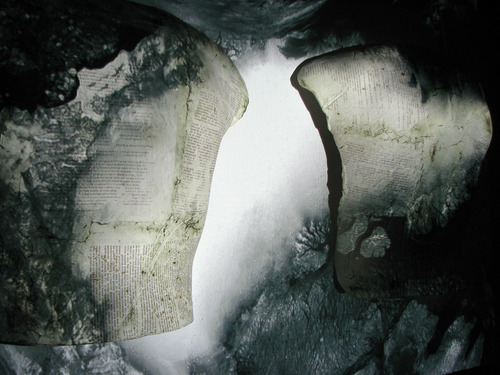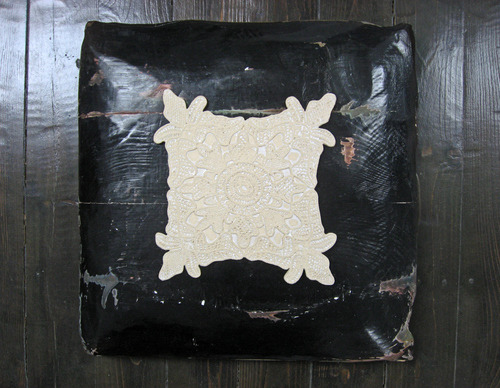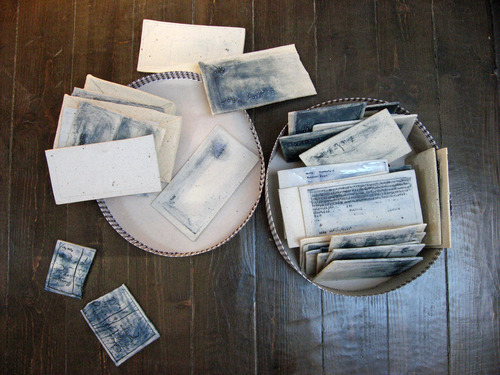
You are a young ceramist who had started her artistic endeavor early on, during college. How did you discover the passion for ceramics?
I guess it was while working. From one work to another you get new ideas; you get excited, you make things. I remember that at the beginning, in high school, I was fascinated to discover how a crude glaze that was a washy orange became dark green after the firing. When you are applying glazes, a significant part of the process is a mental/ imaginative one. While you are mixing and combining them, you need to imagine their true colors, revealed by the firing process.
What message or feeling do you wish to convey to the viewer through your works? Is the goal of your artistic process one of searching and experimenting?
Absolutely! It’s an experiment which starts from the early stages of the work, and includes the viewer’s reaction to the finished piece. The message is open to various interpretations, depending on the power of understanding and interiority of the viewer. It is important for me to create a starting point for a debate.
The refinement and elegance of your works are the result of the techniques that you employ, together with the subtle interventions on the shape. Tell us more about the creative process of your works.
There isn’t anything new or unusual to it. First of all there is the idea. For me it’s important to know if what I’m going to produce is suitable to be made from ceramic material, that the idea will be best expressed with this medium. Then I carefully choose the material, so that it matches and supports my idea. Most of the time, I prefer white clays or sandstone. The majority of my works are composed of more than one piece, so I usually make plaster molds, in which I press the paste, and then I interfere with the form, depending on what I want to do. When I made the ceramic boats (No Direction Home, 2010), I had to do various tests, including testing the paper’s reaction with the ceramic slip. It had to be not too glossy, but neither too rough or to absorb much water. Furthermore, it is essential to know where and when you should stop.

Oriana Pelladi, The dowry, 2011, Stoneware, White glaze, Wooden pillow.
In 2010 you was an artist in residence at Fule International Ceramic Art Museum (FLICAM), Fuping, China. What was the result of this residence?
China is a fascinating country. I lived within a culture with a rich and vast history, one that relates significantly to ceramics. The residence at Fuping has been perfect for me. First of all, I was taken out of the daily context in which I live, away from the little mundane things that interfere with the work. I had my time, I could think and create. I could choose freely from several types of ceramic paste, with high plasticity, provided by the local ceramic factory. It was incredibly nice to work there. Beside this, I experienced working in a studio together with other Romanian and also foreign artists from all over the world – from different generations and with different points of view. It was challenging in terms of creativity, which is a good experience. The residence in which I took part ended with the opening of the Museum of Eastern Europe. Over several years, numerous residences amounted to the creation of the International Museum of Contemporary Ceramics; the museum was composed of several pavilions representing different countries or areas: Scandinavia, America, Australia, Asia, etc. It was a wonderful project, and I was lucky to be part of it. There are many events which deserve to be mentioned. It was captivating. China inspires you.
As an emerging Romanian artist, what do you think is the status of Romanian contemporary ceramics? What do you think is the next step that needs to be done?
It’s growing! It’s taking major steps. Since the time of Romanian Neolithic, ceramic was in good hands. Then the traditional pottery followed, authentic and differentiated according to regions (I must mention at least the black Romanian ceramic), which also had its charm, but unfortunately is disappearing. We are proud of it, but at the same time we neglect it. What I’m trying to say is that traditional ceramics lacks promotion, and the contemporary ceramics also needs support and encouragement. It is true that we (the artists) don’t have good managerial skills, and this blocks our professional approach. As you can see, we know how things should work in theory. Overall, I think it’s important to be consistent in what you believe.

Oriana Pelladi, Inbox, 2010, Stoneware, porcelain, engobes and glazes.
You are in a time of transformation of artistic discourse and approach. Can you tell us more about this transitional period?
Yes, I like to think so. I hope to remain in this continuous state of transformation, to be awake to everything new, to see what is happening around me. I started with the work “The dowry” (which to some measure has to do with my mother) and I intend to develop one or two works, all based on some family memories. It seems that in this time I am closer to this kind of inspiration.
Do you have a project that you’re currently working on?
I started from the phrase “Where you stroke and where it cracks” (a Romanian proverb meaning that an action has an unexpected result, similar to “He struck at Tib, but down fell Tom"), a saying that resonates with our daily experiences. The ceramic material and the chosen form help me to point out the paradox of expression. It’s a work in progress.
Interview by Vasi Hirdo, published in Ceramics Now Magazine, Issue 2. Translation by Anca Sanpetrean.
Visit Oriana Pelladi’s website.
View the list of interviews with ceramic artists.



















